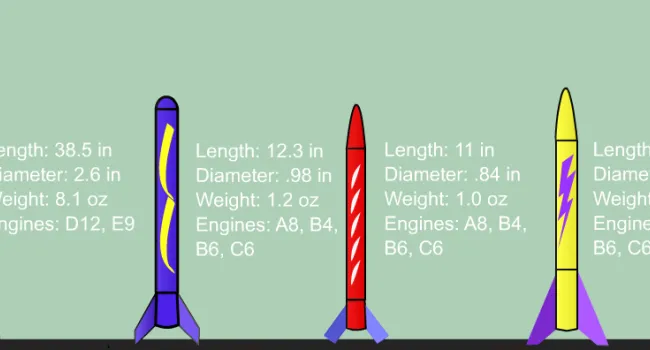In this science-based game, choose and customize a rocket. Launch your rocket and learn about Newton's Laws.
Standards
- Science and Engineering Practices
- Physical Science: Forces and Motion
- 8.P.2 The student will demonstrate an understanding of the effects of forces on the motion and stability of an object.
- 8.P.2A Motion occurs when there is a change in position of an object with respect to a reference point. The final position of an object is determined by measuring the change in position and direction of the segments along a trip. While the speed of the...
- 8.P.2A.3 Construct explanations for the relationship between the mass of an object and the concept of inertia (Newton’s First Law of Motion).
- 8.P.2A.4 Analyze and interpret data to support claims that for every force exerted on an object there is an equal force exerted in the opposite direction (Newton’s Third Law of Motion).
- 8.P.2A.5 Analyze and interpret data to describe and predict the effects of forces (including gravitational and friction) on the speed and direction of an object.
- 8.P.2A.6 Use mathematical and computational thinking to generate graphs that represent the motion of an object’s position and speed as a function of time.
- 8.P.2A Motion occurs when there is a change in position of an object with respect to a reference point. The final position of an object is determined by measuring the change in position and direction of the segments along a trip. While the speed of the...
- 8.P.2 The student will demonstrate an understanding of the effects of forces on the motion and stability of an object.
- Science and Engineering Practices
- Interactions and Forces
- H.P.2 The student will demonstrate an understanding of how the interactions among objects and their subsequent motion can be explained and predicted using the concept of forces.
- H.P.2B The interactions among objects and their subsequent motion can be explained and predicted by analyzing the forces acting on the objects and applying Newton’s laws of motion.
- H.P.2B.1 Plan and conduct controlled scientific investigations involving the motion of an object to determine the relationships among the net force on the object, its mass, and its acceleration (Newton’s second law of motion, Fnet = ma) and analy...
- H.P.2B.3 Use Newton’s Third Law of Motion to construct explanations of everyday phenomena (such as a hammer hitting a nail, the thrust of a rocket engine, the lift of an airplane wing, or a book at rest on a table) and identify the force pairs in...
- H.P.2B The interactions among objects and their subsequent motion can be explained and predicted by analyzing the forces acting on the objects and applying Newton’s laws of motion.
- H.P.2 The student will demonstrate an understanding of how the interactions among objects and their subsequent motion can be explained and predicted using the concept of forces.
- 8.MGSR Measurement, Geometry, and Spatial Reasoning
- 8.MGSR Measurement, Geometry, and Spatial Reasoning
- GS.MGSR Measurement, Geometry, and Spatial Reasoning
- A1.PAFR Patterns, Algebra, and Functional Reasoning
- A2P.PAFR Patterns, Algebra, and Functional Reasoning
Resources
You need to be logged in to listen to view this content. Create an account now; it's quick, easy, and free!
Log In to View